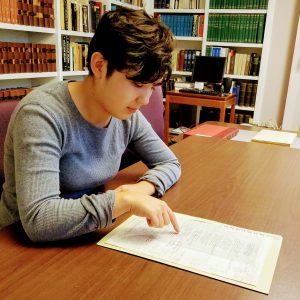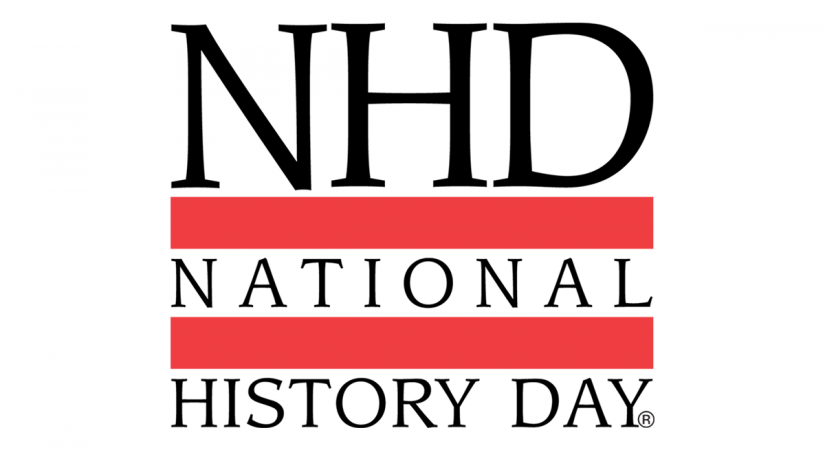If you are participating student, including information from primary sources in your National History Day project will impress your teachers and contest judges and add another layer of research and authenticity to your project. But, working with primary sources can be a challenge because it’s very different from doing research online. The Rosenbach is here to help! We can suggest project topics, guide you towards materials that support that topic, help you learn how to use primary resources and even assist you with finding people to interview!
How do I do research with The Rosenbach?
 To do your research with The Rosenbach, you will first need to choose your topic. Click here for a list of possible National History Day topics.Then, to use the sources at The Rosenbach, you make a research appointment, which you can do by filling out this form rosenbach.org/research/make-an-appointment. Once you submit the form, it will get sent to the Rosenbach’s librarian and she will get in touch with you.
To do your research with The Rosenbach, you will first need to choose your topic. Click here for a list of possible National History Day topics.Then, to use the sources at The Rosenbach, you make a research appointment, which you can do by filling out this form rosenbach.org/research/make-an-appointment. Once you submit the form, it will get sent to the Rosenbach’s librarian and she will get in touch with you.
Need help filling out the research appointment form? Click here.
The Reading Room, which is the place you will do the research at the museum, is open at these times:
You cannot take books or other other library materials home with you. So, try to spend at least a couple hours at the library so that you have enough time. And if you run out of time? You can always make another appointment!
Have you made your appointment to do NHD research at the Rosenbach? Click here to prepare for your visit!
Research Topics
Below are suggested NHD Research Topics to connect to the 2019 Theme: Breaking Barriers in History
Rebel Authors – Breaking Barriers with Literature
Phillis Wheatley: Phillis Wheatley was the first African American poet to be published in the U.S. As a child, Wheatley was brought to America as a slave and learned to read and write from her owners. Her poetry was published at the time with a letter from prominent community members certifying she had written the poems because the public would not have believed that a slave woman was capable of writing them. How did Wheatley break barriers imposed on enslaved people and women?
- Collection links: Editions of her poetry published in 1773 and 1786.
Native American Authors: Native American authors such as Paul Cufee Jr., Robert Benjamin Lewis, Simon Pokagon, and William Apess broke barriers for Native Americans by telling their own stories about the abuse of indigenous people during the settlement of the North American continent.
- Collection links: First and early additions of their works and supporting archival material such as U.S. government treaties with Native American tribes (1800s); explorers’ descriptions of indigenous people; and works produced for the use of Christian missionaries seeking to convert indigneous people to both to Christianity and to a European way of life.
Emily Dickinson: American poet Emily Dickinson was one of the greatest poets of nineteenth century United States but received little recognition during her lifetime. How did Dickinson’s poetry break barriers of literary convention? How did Dickinson break the social conventions of women in the 1800s through her poetry?
- Collection links: Letters between Emily Dickinson and close friend Jane Humphrey 1842-1850.
Miguel de Cervantes: Spanish author Miguel de Cervantes wrote Don Quixote, which is often considered to be the first modern novel. How did Cervantes break barriers of literary convention at the time and what was the legacy of Don Quixote?
- Collection links: Rare first edition of Don Quixote and documents in Cervantes’ hand.
Herman Melville: American author Herman Melville was the author of Moby Dick and other famous works. His works introduced critiques on social inequality, imperialism, and race relations to American readers. How did Melville break barriers by addressing these themes in his writing? How did Herman Melville break barriers with his literary style?
- Collection links: First and early editions of works and several manuscripts.
Breaking Barriers in History
Age of Exploration: European explorers during the Age of Exploration broke down barriers between European civilizations and the civilizations of the Americas. What were the effects on European and indigenous American civilizations?
- Collection links: Letters and other writings of Spanish explorers Cortes and Pizarro.
American Independence and the Revolutionary War: What were the barriers to American independence and how did the Founding Fathers help to break down those barriers?
- Collection links: Letters written by George Washington, John Adams, Benjamin Franklin, and Thomas Jefferson; Benjamin Franklin’s Poor Richard
Early Abolitionism in America: Benjamin Lay and Ralph Sandiford were early Philadelphia-based Quaker abolitionists in the 1700s. How did early abolitionists such as Lay and Sandiford help to break barriers for enslaved persons and what was their impact on the abolitionist movement?
- Collection links: A Brief Examination of the Times by Ralph Sandiford; robust supporting archival material.
Westward Expansion and John C. Fremont: During the 1800s, John C. Fremont was an explorer of the American West, military officer during the Mexican-American war, and Senator. How did Fremont’s published works from his expeditions in the American West break barriers for future emigrants to the Western territories? What were the effects of Westward Expansion as territorial barriers were broken down in pursuit of “manifest destiny”?
- Collection links: Topographical map of the Oregon Trail; field notes of John C. Fremont’s overland journeys; Year of American Travel by Jessie Benton Fremont.
The Civil War & Telegrams: The Civil War was the first large-scale war in U.S. history that utilized telegraphy for communication. Telegraphy helped to overcome barriers to effective communication – distance and time – by increasing the speed and accuracy of communication during the war. How do you think this impacted the Civil War?
- Collection links: Telegrams sent between Confederate generals about troop movements throughout the war; telegrams sent from U.S. Navy Department about the manhunt for John Wilkes Booth after Lincoln’s assassination.
Isabelle “Belle” Boyd: The infamous female spy Belle Boyd provided important information to the Confederate Army that she gathered from Union soldiers during the Civil War. How did Belle Boyd break barriers of convention surrounding women in society? How did she use those barriers to her advantage?
- Collection links: Autograph album and scrapbook containing letters, comments, and newspaper clippings.
Abraham Lincoln: Lincoln served as the 16th president of the United States and led the U.S. through the Civil War. To what extent did Abraham Lincoln break down the barriers of slavery by issuing the Emancipation Proclamation?
- Collection links: More than 60 letters written by Lincoln.
National History Day Research Appointment Form FAQ
Q: If I’m not sure what to put in a field, what should I do?
A: You can put something like “unsure”. The Librarian will be in touch with you with any questions!
Q: What do I put in the “Purpose” field?
A: You can put National History Day. The librarian will know what that means.
Q: What do I put for “Type of project”?
A: If you know which kind of NHD project: paper, performance, presentation, you can put that. If you aren’t sure yet, put what you are thinking of doing.
Q: What if I don’t know what specific material I will need yet?
A: That’s fine! You can put “I don’t know” or put the general topic – the librarian will ask questions and/or gather several options for you.
Q: What if I change my mind at some point?
A: That’s ok! Reach out to the librarian, or when you are at your appointment, you can talk about what you are thinking of changing to.
NHD Research at the Rosenbach FAQ
Q: Can my research group come together to research?
A: Yes, but each person needs to fill out their own research appointment form.
Q: Ok, I made an appointment and it has been confirmed. Now what?
A: To get into the Rosenbach’s Reading Room, make sure you have a school ID. If you don’t have a school ID, you can use an institutional identification card, a driver’s license, or passport. You will have to fill out a form about what you want to research and why. This is so staff members can help you locate what you need.
Q: What should I bring with me? What can I bring with me? What can’t I bring with me?
- You need something to take notes with – PENCILS ONLY to write with.
- You may bring a laptop or tablet or something similar to take notes on if you choose.
- Before you take pictures, you have to fill out a form – you can ask for this. If you take pictures, you CANNOT use flash. Ask the librarian for this form.
- You cannot bring a book bag, purse, computer bag, or anything like that into the room with you, but there are lockers with removable keys that you can use to store those things. The lockers are free!
- You can only bring other books in with special permission. You can ask the librarian for permission when she contacts you to set up the research appointment.
- You may have your notebook/papers/etc. inspected by staff before leaving – this is to make sure all rules are followed.
- Food and drink is not allowed in the reading room
Research Dos and Don’ts
- DO treat all materials with care. If you have a question about how to treat an item, ask!
- DO turn pages carefully, and DO use a book holder if told to.
- DO handle art by their paper frames only.
- DO cite your sources. Check the Chicago Style Handbook or MLA handbook if you have any questions, or go online to OWL at Purdue for help.
- DO ask for help if you need it. The staff members are here to help!
- DON’T put anything on the items except for book weights which keep the pages of the books open.
- DON’T try to fix something if it seems out of place. Ask a staff member for help.
Students under the age of 13 of must be accompanied by a parent/guardian.

